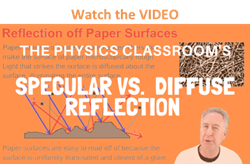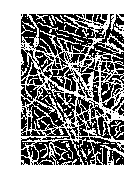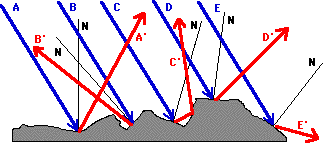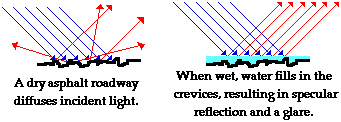Hold down the T key for 3 seconds to activate the audio accessibility mode, at which point you can click the K key to pause and resume audio. Useful for the Check Your Understanding and See Answers.
 It was mentioned earlier in this lesson that light reflects off surfaces in a very predictable manner - in accordance with the law of reflection. Once a normal to the surface at the point of incidence is drawn, the angle of incidence can then be determined. The light ray will then reflect in such a manner that the angle of incidence is equal to the angle of reflection. This predictability concerning the reflection of light is applicable to the reflection of light off of level (horizontal) surfaces, vertical surfaces, angled surfaces, and even curved surfaces. As long as the normal (perpendicular line to the surface) can be drawn at the point of incidence, the angle of incidence can be measured and the direction of the reflected ray can be determined. A series of incident rays and their corresponding reflected rays are depicted in the diagram below. Each ray strikes a surface with a different orientation; yet each ray reflects in accordance with the law of reflection.
It was mentioned earlier in this lesson that light reflects off surfaces in a very predictable manner - in accordance with the law of reflection. Once a normal to the surface at the point of incidence is drawn, the angle of incidence can then be determined. The light ray will then reflect in such a manner that the angle of incidence is equal to the angle of reflection. This predictability concerning the reflection of light is applicable to the reflection of light off of level (horizontal) surfaces, vertical surfaces, angled surfaces, and even curved surfaces. As long as the normal (perpendicular line to the surface) can be drawn at the point of incidence, the angle of incidence can be measured and the direction of the reflected ray can be determined. A series of incident rays and their corresponding reflected rays are depicted in the diagram below. Each ray strikes a surface with a different orientation; yet each ray reflects in accordance with the law of reflection.

|
|
The Law of Reflection is Always Observed
(regardless of the orientation of the surface)
|
 In physics class, the behavior of light is often studied by observing its reflection off of plane (flat) mirrors. Mirrors are typically smooth surfaces, even at the microscopic levels. As such, they offer each individual ray of light the same surface orientation. But quite obviously, mirrors are not the only types of objects which light reflects off of. Most objects which reflect light are not smooth at the microscopic level. Your clothing, the walls of most rooms, most flooring, skin, and even paper are all rough when viewed at the microscopic level. The picture at the right depicts a highly magnified, microscopic view of the surface of a sheet of paper.
In physics class, the behavior of light is often studied by observing its reflection off of plane (flat) mirrors. Mirrors are typically smooth surfaces, even at the microscopic levels. As such, they offer each individual ray of light the same surface orientation. But quite obviously, mirrors are not the only types of objects which light reflects off of. Most objects which reflect light are not smooth at the microscopic level. Your clothing, the walls of most rooms, most flooring, skin, and even paper are all rough when viewed at the microscopic level. The picture at the right depicts a highly magnified, microscopic view of the surface of a sheet of paper.
Reflection off of smooth surfaces such as mirrors or a calm body of water leads to a type of reflection known as specular reflection. Reflection off of rough surfaces such as clothing, paper, and the asphalt roadway leads to a type of reflection known as diffuse reflection. Whether the surface is microscopically rough or smooth has a tremendous impact upon the subsequent reflection of a beam of light. The diagram below depicts two beams of light incident upon a rough and a smooth surface.

A light beam can be thought of as a bundle of individual light rays which are traveling parallel to each other. Each individual light ray of the bundle follows the law of reflection. If the bundle of light rays is incident upon a smooth surface, then the light rays reflect and remain concentrated in a bundle upon leaving the surface. On the other hand, if the surface is microscopically rough, the light rays will reflect and diffuse in many different directions.
Why Does a Rough Surface Diffuse A Beam of Light?
For each type of reflection, each individual ray follows the law of reflection. However, the roughness of the material means that each individual ray meets a surface which has a different orientation. The normal line at the point of incidence is different for different rays. Subsequently, when the individual rays reflect off the rough surface according to the law of reflection, they scatter in different directions. The result is that the rays of light are incident upon the surface in a concentrated bundle and are diffused upon reflection. The diagram below depicts this principle. Five incident rays (labeled A, B, C, D, and E) approach a surface. The normal line (approximated) at each point of incidence is shown in black and labeled with an N. In each case, the law of reflection is followed, resulting in five reflected rays (labeled A,, B,, C,, D,, and E,).

Applications of Specular and Diffuse Reflection
There are several interesting applications of this distinction between specular and diffuse reflection. One application pertains to the relative difficulty of night driving on a wet asphalt roadway compared to a dry asphalt roadway. Most drivers are aware of the fact that driving at night on a wet roadway results in an annoying glare from oncoming headlights. The glare is the result of the specular reflection of the beam of light from an oncoming car. Normally a roadway would cause diffuse reflection due to its rough surface. But if the surface is wet, water can fill in the crevices and smooth out the surface. Rays of light from the beam of an oncoming car hit this smooth surface, undergo specular reflection and remain concentrated in a beam. The driver perceives an annoying glare caused by this concentrated beam of reflected light.

A second application of the distinction between diffuse and specular reflection pertains to the field of photography. Many people have witnessed in person or have seen a photograph of a beautiful nature scene captured by a photographer who set up the shot with a calm body of water in the foreground. The water (if calm) provides for the specular reflection of light from the subject of the photograph. Light from the subject can reach the camera lens directly or it can take a longer path in which it reflects off the water before traveling to the lens. Since the light reflecting off the water undergoes specular reflection, the incident rays remain concentrated (instead of diffusing). The light is thus able to travel together to the lens of the camera and produce an image (an exact replica) of the subject which is strong enough to perceive in the photograph. An example of such a photograph is shown below.

Photograph of Mount Moran in the Grand Teton National Park in Wyoming - taken by Becky Henderson
|
.
Check Your Understanding
1. If a bundle of parallel incident rays undergoing diffuse reflection follow the law of reflection, then why do they scatter in many different directions after reflecting off a surface?
2. Perhaps you have observed magazines which have glossy pages. The usual microscopically rough surface of paper has been filled in with a glossy substance to give the pages of the magazine a smooth surface. Do you suppose that it would be easier to read from rough pages or glossy pages? Explain your answer.